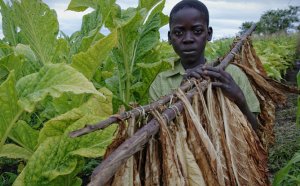
Tobacco in Colonial Virginia
 The history of tobacco is the history of Jamestown and of Virginia. No one staple or resource ever played a more significant role in the history of any state or nation. The growth of the Virginia Colony, as it extended beyond the limits of Jamestown, was governed and hastened by the quest for additional virgin soil in which to grow this “golden weed.” For years the extension into the interior meant the expansion of tobacco production. Without tobacco the development of Virginia might have been retarded 200 years.
The history of tobacco is the history of Jamestown and of Virginia. No one staple or resource ever played a more significant role in the history of any state or nation. The growth of the Virginia Colony, as it extended beyond the limits of Jamestown, was governed and hastened by the quest for additional virgin soil in which to grow this “golden weed.” For years the extension into the interior meant the expansion of tobacco production. Without tobacco the development of Virginia might have been retarded 200 years.
Tobacco was the life and soul of the colony; yet a primitive, but significant, form of diversified farming existed from the very beginning especially among the small farmers. Even with the development of the large plantations in the eighteenth century, there were quite a number of small landowners interspersed among the big planters in the Tidewater area, and they were most numerous in the Piedmont section. They usually possessed few slaves, if any, and raised mostly grains, vegetables and stock which they could easily sell to neighboring tobacco planters. The negligible food imports by the colony indicates that a regular system of farming existed. Nor was tobacco the sole product of the large tobacco plantations. This is indicated by the fact that practically all of the accounts of the product of one man’s labor were recorded as so many pounds or acres of tobacco plus provisions. And had the plantations not been generally self-sufficient, the frequently extremely low prevailing tobacco prices would have made the agricultural economy even less profitable.
Tobacco was a completely new agricultural product to most, if not all, of the English settlers at Jamestown. There were no centuries of vast experience in growing, curing, and marketing to draw upon. These problems and procedures were worked out by trial and error in the wilderness of Virginia. Tobacco became the only dependable export and the colony was exploited for the benefit of English commerce. This English commercial policy, plus other factors, caused the Virginia planter to become somewhat of an agricultural spendthrift. For nearly 200 years he followed a system of farming which soon exhausted his land. Land was cheap and means of fertilization was limited and laborious. By clearing away the trees he was able to move north, south, southwest, and west and replace his worn-out fields with rich virgin soil necessary to grow the best tobacco.
While struggling with the problems involved in producing an entirely new crop about which they knew little or nothing, the colonists also had to feed themselves, deal with their racial problems, and maintain a stable local government as they continually expanded in a limitless wilderness. Out of all this chaos grew the mother and leader of the American colonies.
Tobacco penetrated the social, political, and economic life of the colony. Ownership of a large tobacco plantation could take one up the social ladder; many of the men responsible for the welfare of the colony were planters, and everything could be paid for in tobacco. In 1620 the indentured servants were paid for with tobacco, the young women sent to the colonists to become wives were purchased by paying their transportation charges with tobacco. The wages of soldiers and the salaries of clergymen and governmental officials were paid in tobacco. After 1730 tobacco notes, that is warehouse receipts, representing a certain amount of money, served as currency for the colony.
The development of the inspection system with its chain of tobacco warehouses hastened urbanization. Around many of these warehouses grew villages and settlements; some of these eventually became towns and cities. Richmond, Petersburg, Danville, Fredericksburg, Farmville, Clarksville and others were once merely convenient landings or locations for tobacco warehouses. Even today the fragrant aroma of cured tobacco still exists in a number of these places during the tobacco marketing season. The tobacco trade was largely responsible for the birth and growth of Alexandria, Dumfries, and Norfolk into important export-import centers. For her birth, growth, and colonial leadership, Virginia pays her respect to John Rolfe and the other brave settlers at Jamestown.
Tobacco is still [1957] a vital factor in Virginia’s economy. Of approximately 2, 000, 000 acres of cropland (pastureland excluded) in 1949, 115, 400 were planted in tobacco which produced 124, 904, 000 pounds valued at $55, 120, 800 or twenty-three percent of the total value of all agricultural crops. Of the four largest agricultural products–poultry, tobacco, meat animals, and milk–tobacco ranked second only to poultry in terms of income in 1955. Poultry produced an income of $99, 935, 000, tobacco $84, 128, 000, meat animals $80, 564, 000, and milk $70, 681, 000. Peanuts and fruits were tied for fifth place, each producing an income of about $21, 000, 000.
VIDEO REVIEWS



Share this Post
Related posts
Tobacco in history
The Tobacco Valley Board of History former name was the Tobacco Valley Improvement Association (TVIA). TVIA was formed in…
Read MoreHistory of tobacco in the United States
600 BC First tobacco plant grows in the Americas 1 BC American inhabitants begin smoking tobacco 1492 Columbus finds tobacco…
Read More










